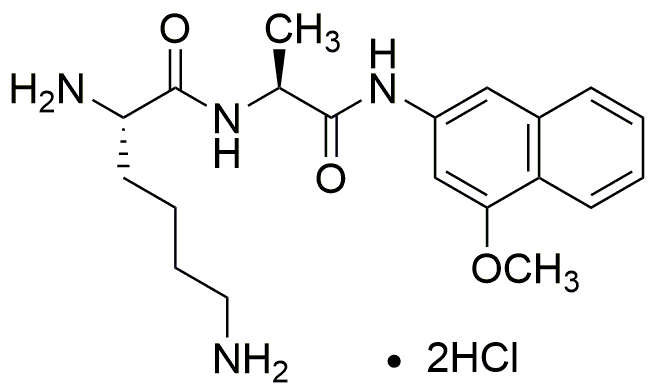H-Lys-Ala-4MbNA·2HCl is widely utilized in research focused on:
- Peptide Synthesis: This compound serves as a building block in the synthesis of peptides, which are essential for developing new drugs and therapeutic agents.
- Bioconjugation: It is used in bioconjugation processes to attach drugs or imaging agents to biomolecules, enhancing targeted delivery in cancer therapies.
- Enzyme Inhibition Studies: Researchers utilize this compound to study enzyme inhibition, aiding in the development of inhibitors that can be used in various medical treatments.
- Diagnostics: H-Lys-Ala-4MbNA·2HCl plays a role in the development of diagnostic tools, particularly in assays that require specific peptide interactions.
- Drug Development: Its unique properties make it valuable in drug formulation, particularly for creating more effective and stable pharmaceutical products.
General Information
Properties
Safety and Regulations
Applications
H-Lys-Ala-4MbNA·2HCl is widely utilized in research focused on:
- Peptide Synthesis: This compound serves as a building block in the synthesis of peptides, which are essential for developing new drugs and therapeutic agents.
- Bioconjugation: It is used in bioconjugation processes to attach drugs or imaging agents to biomolecules, enhancing targeted delivery in cancer therapies.
- Enzyme Inhibition Studies: Researchers utilize this compound to study enzyme inhibition, aiding in the development of inhibitors that can be used in various medical treatments.
- Diagnostics: H-Lys-Ala-4MbNA·2HCl plays a role in the development of diagnostic tools, particularly in assays that require specific peptide interactions.
- Drug Development: Its unique properties make it valuable in drug formulation, particularly for creating more effective and stable pharmaceutical products.
Documents
Safety Data Sheets (SDS)
The SDS provides comprehensive safety information on handling, storage, and disposal of the product.
Product Specification (PS)
The PS provides a comprehensive breakdown of the product’s properties, including chemical composition, physical state, purity, and storage requirements. It also details acceptable quality ranges and the product's intended applications.
Certificates of Analysis (COA)
Search for Certificates of Analysis (COA) by entering the products Lot Number. Lot and Batch Numbers can be found on a product’s label following the words ‘Lot’ or ‘Batch’.
*Catalog Number
*Lot Number
Certificates Of Origin (COO)
This COO confirms the country where the product was manufactured, and also details the materials and components used in it and whether it is derived from natural, synthetic, or other specific sources. This certificate may be required for customs, trade, and regulatory compliance.
*Catalog Number
*Lot Number
Safety Data Sheets (SDS)
The SDS provides comprehensive safety information on handling, storage, and disposal of the product.
DownloadProduct Specification (PS)
The PS provides a comprehensive breakdown of the product’s properties, including chemical composition, physical state, purity, and storage requirements. It also details acceptable quality ranges and the product's intended applications.
DownloadCertificates of Analysis (COA)
Search for Certificates of Analysis (COA) by entering the products Lot Number. Lot and Batch Numbers can be found on a product’s label following the words ‘Lot’ or ‘Batch’.
*Catalog Number
*Lot Number
Certificates Of Origin (COO)
This COO confirms the country where the product was manufactured, and also details the materials and components used in it and whether it is derived from natural, synthetic, or other specific sources. This certificate may be required for customs, trade, and regulatory compliance.


